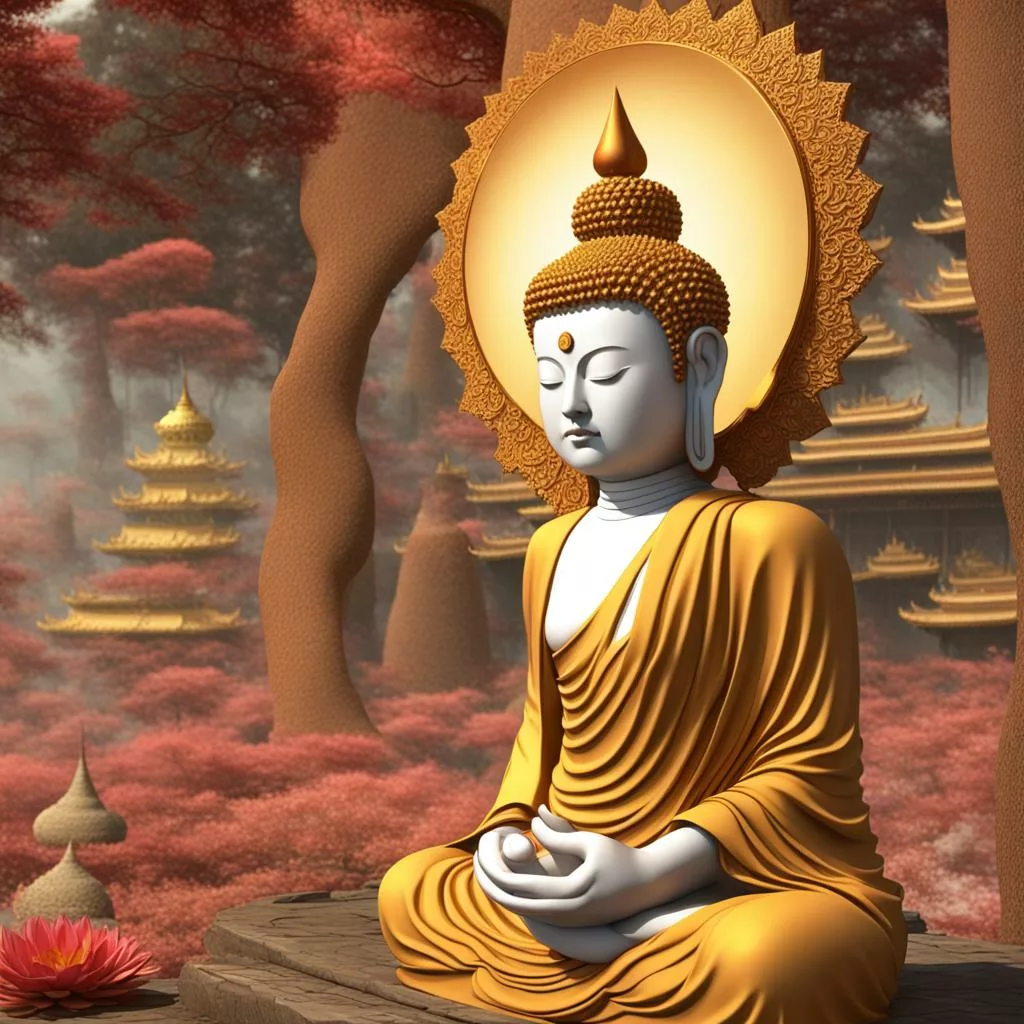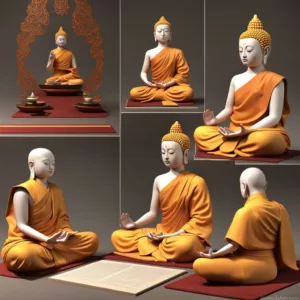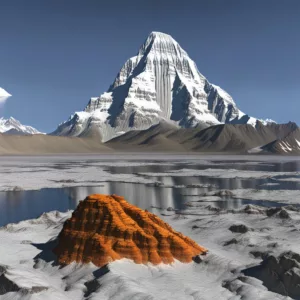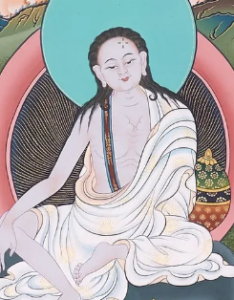
Reincarnation in Buddhism is part of the Buddhist reincarnation cycle – the 12 links of interdependent existence called the nidanas.
I find karma (a core aspect of reincarnation) to be one of the most difficult of Buddhist subjects.
Secrets of Meditation for Anxiety
Like millions of people, you may have suffered from anxiety for years. Meditation, yoga, peaceful music – it never works. It takes too long, and it’s not stable. Why? Because peace is treated as a cause for freedom, but it’s not – it’s the result. The cause to free yourself from anxiety is completely different.
Click now to Overcome Anxiety for good.
Table of Contents
Reincarnation in Buddhism, Summary
Certainly! Here’s an entity knowledge graph for reincarnation in Buddhism presented in a table format:
| Entity | Description | Related Concepts | Examples/Practices | Sources |
|---|---|---|---|---|
| Reincarnation | The cycle of birth, death, and rebirth experienced by all beings. | Samsara, Karma | Meditation on past lives, ethical living | ReligionFacts, Learn Religions |
| Samsara | The endless cycle of birth, death, and rebirth. | Reincarnation, Nirvana | Contemplation, Wheel of Life visualization | BBC, Britannica |
| Karma | The law of moral causation; actions determine future experiences. | Rebirth, Samsara | Ethical conduct, merit-making activities | BBC, ReligionFacts |
| Nirvana | Liberation from the cycle of Samsara and cessation of suffering. | Enlightenment, Liberation | Following the Noble Eightfold Path | Learn Religions, BBC |
| Six Realms | Realms of existence within Samsara: Gods, Demigods, Humans, Animals, Hungry Ghosts, Hell Beings | Rebirth, Karma | Visualization practices, ethical living | Britannica, BBC |
| Bodhisattva | Enlightened beings who choose to be reborn to help others achieve liberation. | Compassion, Rebirth | Altruistic actions, Bodhisattva vows | Britannica, ReligionFacts |
| Past Lives | Previous existences before the current life; influence present karma and circumstances. | Karma, Reincarnation | Meditation on past lives, reflection | Learn Religions, ReligionFacts |
| Noble Eightfold Path | The path to liberation and Nirvana; includes right understanding, intention, speech, action, livelihood, effort, mindfulness, and concentration. | Nirvana, Ethical conduct | Meditation, mindful living, ethical actions | BBC, Britannica |
| Merit-Making | Actions that generate positive karma, influencing future rebirths positively. | Karma, Rebirth | Charity, offering food to monks, rituals | Learn Religions, ReligionFacts |
| Wheel of Life (Bhavachakra) | A symbolic representation of Samsara, depicting the six realms and the cycle of rebirth. | Samsara, Karma, Rebirth | Visualization practices, teaching tool | Britannica, ReligionFacts |
These entities collectively describe the concept of reincarnation in Buddhism, its philosophical underpinnings, and practical implications. They provide a holistic understanding of how actions influence rebirth, the ultimate goal of achieving liberation, and the moral framework guiding Buddhist practice.
Introduction
The Buddhism reincarnation chart can give a handy reference for this post. Reincarnation is a cornerstone of Buddhist philosophy, painting a profound picture of life, death, and rebirth. Unlike the common Western conception of a linear life ending in an eternal afterlife, Buddhism offers a cyclical perspective through the lens of Samsara—the endless cycle of birth, death, and rebirth. This cycle is not just a mystical concept but a deeply embedded part of the Buddhist path to understanding existence and ultimately achieving liberation.
Having spent three decades immersed in meditation practice, countless solitary and group retreats, and as a meditation instructor, I’ve found that contemplating reincarnation can lead to profound insights and shifts in perspective. It’s a concept that encourages a deeper connection to the present moment and fosters a compassionate outlook on life and death.
Historical Context for Reincarnation in Buddhism
The idea of reincarnation did not originate with Buddhism. It has deep roots in Indian spiritual traditions, particularly in Hinduism, where it’s intertwined with the concepts of karma and dharma. When Siddhartha Gautama, who later became known as the Buddha, formulated his teachings, he adopted and adapted these pre-existing ideas into a unique framework that emphasized the cessation of suffering.
In the historical context, reincarnation was seen as an inevitable process fueled by one’s actions (karma). The Buddha’s revolutionary approach focused not merely on living a righteous life to secure a better rebirth but on breaking free from the cycle of rebirth altogether. This liberation, known as Nirvana, became the ultimate goal, representing freedom from the endless cycles of Samsara.
Reincarnation in Buddhism: The Concept of Samsara
Samsara, often referred to as the wheel of life, is a fundamental concept in Buddhism representing the endless cycle of birth, death, and rebirth. It’s driven by karma—the law of moral causation. Our actions, whether positive or negative, set the stage for future experiences. This cycle is seen as a form of suffering, as beings are perpetually reborn into varying conditions based on their past actions.
Within Samsara, there are six realms of existence: Gods, Demigods, Humans, Animals, Hungry Ghosts, and Hell beings. Each realm offers different experiences and levels of suffering or pleasure, but all are impermanent and unsatisfactory in the long run. The human realm is considered particularly precious because it offers a unique balance of suffering and opportunity, making it an ideal condition for practicing the Dharma and working towards liberation.
Understanding Samsara not only helps us grasp the Buddhist view of existence but also underscores the importance of our actions. It’s a call to live mindfully, ethically, and compassionately, knowing that our deeds resonate beyond this lifetime.
By integrating these concepts into meditation and daily practice, one begins to see life through a broader, more interconnected lens, fostering a sense of responsibility and empathy for all beings trapped in the cycle of Samsara. This perspective, cultivated over years of dedicated practice and teaching, can be deeply transformative, guiding practitioners towards a path of wisdom and compassion.
How to meditate like a yogi
and enter profound samadhi
Reincarnation in Buddhism: Karma and Rebirth
Karma, often misunderstood in the West, is a pivotal concept in Buddhism that directly influences the process of rebirth. Unlike the notion of fate or predestination, karma refers to the intentional actions we perform, which leave imprints on our consciousness. These actions, whether wholesome or unwholesome, shape our future experiences in the cycle of Samsara.
In practical terms, karma functions through the ethical law of cause and effect. Positive actions, such as acts of generosity, kindness, and compassion, lead to positive results, potentially a favorable rebirth. Conversely, negative actions, such as harm, deceit, and hatred, lead to suffering and less favorable conditions. This continuous interplay of actions and their consequences creates a moral framework that encourages ethical living and mindfulness.
Imagine the ripple effect of tossing a stone into a pond—each action we take generates ripples that extend far beyond the initial impact. In my own journey as a meditator and instructor, I’ve seen how understanding and applying the principles of karma can transform one’s approach to life. By cultivating positive actions and intentions, practitioners can influence their present and future, steering towards a more harmonious existence and a favorable rebirth.
Reincarnation in Buddhism: The Six Realms of Existence
The six realms of existence, depicted in the Wheel of Life (Bhavachakra), represent the different states into which beings can be reborn, based on their karma. These realms are:
- Gods (Devas): A realm of pleasure and longevity, yet marked by the suffering of impermanence and eventual fall due to pride.
- Demigods (Asuras): Characterized by jealousy and conflict, beings here are powerful but constantly embroiled in struggle and envy.
- Humans: The realm of balance, providing the optimal conditions for practicing Dharma due to the mixture of pleasure and pain.
- Animals: Marked by ignorance and instinctual living, beings in this realm experience suffering due to exploitation and lack of higher understanding.
- Hungry Ghosts (Pretas): A realm of insatiable desire and deprivation, where beings suffer from unfulfilled cravings.
- Hell Beings: Encompassing various hells, this realm is characterized by intense suffering and punishment as a result of severely negative karma.
Each realm reflects different aspects of suffering and provides a vivid depiction of the consequences of our actions. The human realm is particularly valued in Buddhist practice because it offers a unique balance that is conducive to spiritual growth. Here, we experience enough suffering to motivate us to seek liberation, yet we also have the capacity for wisdom and ethical conduct.
The stories and teachings about these realms are not just metaphors but are intended to provoke a deep introspection about our actions and their long-term effects. In my years of teaching and meditation, reflecting on these realms has been a powerful tool for cultivating compassion and understanding the profound interconnectedness of all beings.
By contemplating the six realms, practitioners can develop a sense of urgency and dedication to their practice, striving to act in ways that lead to a favorable rebirth and ultimately, liberation from the cycle of Samsara. This holistic view fosters a compassionate and mindful approach to life, encouraging us to transcend our immediate desires and consider the broader impact of our actions.



Attaining Liberation (Reincarnation in Buddhism)
The concept of Nirvana is central to Buddhist practice and represents the ultimate liberation from the cycle of Samsara. Achieving Nirvana means transcending the endless cycles of birth, death, and rebirth, thus escaping the suffering that pervades all realms of existence. This liberation is the culmination of a long and dedicated path of ethical conduct, meditation, and wisdom.
In Buddhism, the path to liberation is outlined by the Noble Eightfold Path, which consists of right understanding, right intention, right speech, right action, right livelihood, right effort, right mindfulness, and right concentration. Each aspect of this path is designed to cultivate the qualities necessary for breaking free from Samsara. Through mindfulness and meditation, practitioners develop deep insights into the nature of reality, seeing through the illusions that bind them to the cycle of rebirth.
A significant aspect of this journey involves the stories of enlightened beings, or Bodhisattvas. These are individuals who have attained enlightenment but choose to be reborn out of compassion, to assist others in their path to liberation. One of the most renowned Bodhisattvas is Avalokiteshvara, the embodiment of infinite compassion, who vows to remain in Samsara until all beings are liberated.
In my experience guiding meditation and participating in retreats, the aspiration to achieve liberation and help others along the way is a powerful motivator. It’s not just about personal freedom but also about contributing to the well-being of all sentient beings, echoing the Bodhisattva vow.
Personal Reflections on Reincarnation in Buddhism
Reflecting on reincarnation through years of meditation practice and teaching has offered profound insights. One particularly memorable retreat involved deep contemplation on past lives and the interconnectedness of all beings. This practice not only deepened my understanding of karma but also fostered a sense of compassion and responsibility for others.
Meditation sessions often involve visualizations and reflections on the transient nature of existence, emphasizing the impermanence of all states and the continuity of consciousness. These reflections can be transformative, helping to cultivate a more mindful and compassionate approach to everyday interactions.
As a meditation instructor, I’ve seen students undergo significant changes when they truly grasp the implications of reincarnation and karma. It encourages a shift from self-centered behaviors to more altruistic actions, knowing that our deeds echo far beyond this lifetime.
Reincarnation in Buddhism: Conclusion
Reincarnation in Buddhism offers a profound and expansive view of life, challenging us to see beyond the confines of our immediate existence. By understanding and contemplating Samsara, karma, and the paths to liberation, we gain deeper insights into the nature of reality and our place within it. This understanding can be a powerful catalyst for personal and spiritual growth, guiding us towards a more compassionate and mindful way of living.
I invite you to explore these concepts further, whether through personal meditation practice, reading, or participating in retreats. Embracing the teachings on reincarnation can transform our lives, offering a path to greater wisdom and compassion.
Additional Resources
**Books**:
– “The Tibetan Book of Living and Dying” by Sogyal Rinpoche
– “Rebirth in Tibetan Buddhism: The Third Karmapa and the Invention of a Tradition” by Geoffrey Samuel
– **Articles**:
– “Buddhist Views on Reincarnation and the Cycle of Samsara” – [Learn Religions](https://www.learnreligions.com/reincarnation-in-buddhism-450094)
– “Understanding Karma and Rebirth” – [Buddhist Society](https://thebuddhistsociety.org/page/rebirth)
– **Online Courses**:
– Introduction to Buddhist Meditation and Teachings on Reincarnation – [Coursera](https://www.coursera.org)
– Deepening Your Practice: Karma and Rebirth – [Udemy](https://www.udemy.com)
By engaging with these resources, you can deepen your understanding of Buddhist reincarnation and incorporate these teachings into your own spiritual journey.

May all beings be happy
May all beings be peaceful
May all beings be safe
May all beings awaken to the light of their true nature
May all beings be free







